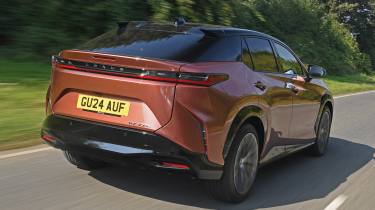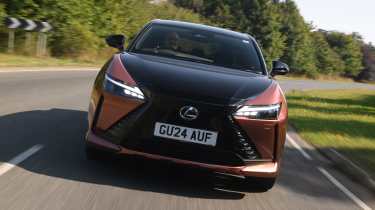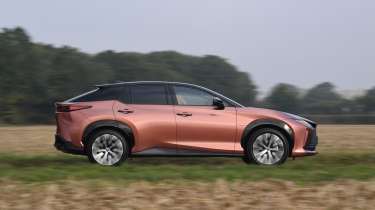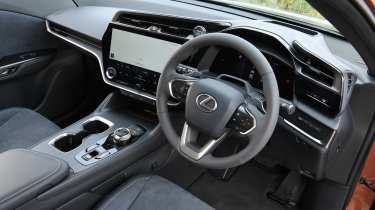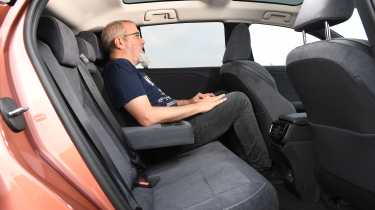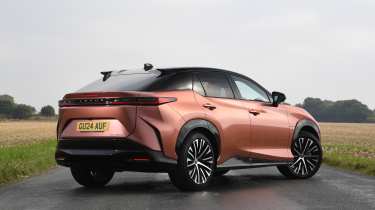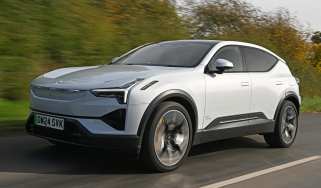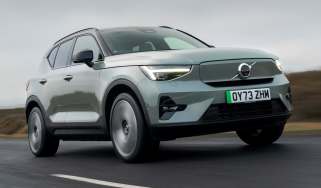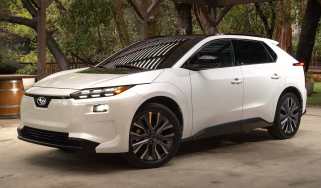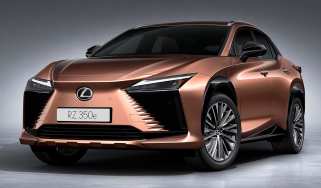Lexus RZ review – classy and comfortable, but off the pace of some rivals
“The Lexus RZ is the first electric mid-size SUV from the brand as it ushers in new technology and aims to take on the Tesla Model Y”
Pros
- Quiet and classy interior
- Comfortable ride
- 150kW fast charging
Cons
- Average driving range
- Not especially exciting to drive
- Higher trims are expensive
Verdict – is the Lexus RZ a good car?
The Lexus RZ is a good attempt at a ground-up electric car that sits in the all-important mid-size SUV class. It delivers excellent refinement, an appealing interior, and enough performance to satisfy most buyers. While it’s not as exciting to drive as Lexus may have hoped, and its 297-mile maximum driving range can’t match the class-leaders, few EVs deliver the quality and refinement on offer here – especially for around £50,000.
Lexus RZ models, specs and alternatives
The Lexus RZ is the Japanese manufacturer’s first-ever model that’s been designed from its inception to be powered purely by electricity. It is a medium-sized SUV that shares a lot of its hidden parts with the Toyota bZ4X and Subaru Solterra, thanks to the significant collaboration between the brands. Lexus’ range also includes the smaller Lexus UX, which is available as a hybrid and electric UX 300e, costing from around £41,000.
Lexus is aiming to be an all-electric brand in the UK by 2030, so the RZ has the important role of setting things off on the right foot. It enters a growing segment of high-riding EV models, and upmarket rivals include the Audi Q4 e-tron, Polestar 4 and Tesla Model Y.
The RZ is smaller than the brand’s flagship SUV, the Lexus RX, but it wasn’t much cheaper when it first went on sale, costing around £58,000. That was until the more affordable RZ 300e arrived – it ditches the dual-motor layout of the original car for a less powerful single-motor configuration, allowing for a lower £50,000 starting price. The Tesla Model Y is still the cheaper option, though, costing from around £47,000.
The RZ launched in 450e guise, coming with a 201bhp front motor and a 107bhp rear motor for a 308bhp combined output. They’re now fed by a 71kWh battery pack, which is a bit lower in capacity compared to some of its rivals. Maximum range is rated at 272 miles for entry-level trims, dropping to just over 250 miles for range-topping versions with large 20-inch alloy wheels.
In late 2024, Lexus expanded the RZ range with the 300e. This gets the same rear motor as the 450e and does away with the front motor completely, while sticking with the same 71kWh battery pack. It’s a bit slower as a result, but range was usefully increased to 297 miles – a trade-off that makes sense for many buyers, and that’s before considering its cheaper price tag, but still puts it firmly behind the 373-mile range of the Model Y Long Range RWD.
Charging is pretty quick, with up to 150kW possible at compatible DC public charging stations; enough for a 10 to 80% charge in half an hour. The RZ also comes with 11kW home charging as standard, although most UK households won’t be able to benefit from more than 7kW unless they have their supply upgraded to three-phase AC.
New for late 2024 was the entry-level Urban trim level, which joined Premium, Premium Plus and Takumi. Even the most basic RZ gets LED headlights, a 14-inch infotainment system, dual-zone climate control and a heated steering wheel. Pay for one of the pricier trim levels, and you’ll get niceties such as a head-up display, 360-degree camera view and bigger alloy wheels. The top-spec RZ 450e Takumi model costs over £65,000 and brings a dimmable panoramic sunroof, adaptive suspension and other luxuries.
| Trim levels | Power options |
|
|
Lexus RZ alternatives
Family SUV EVs
Premium SUV EVs
Mid-size SUVs
Range, charging & running costs
Both the RZ 450e and 300e use a relatively small 71kWh battery pack. As a comparison, the Polestar 4 has a 94kWh pack, while the Audi Q4-etron has up to 77kWh, which pays dividends in a relatively large and heavy SUV. On a single charge, the RZ 300e can manage up to 297 miles, compared with up to 385 miles for the Polestar and 342 miles for the Audi. The Peugeot E-3008 is more affordable than the Lexus but can manage up to 435 miles thanks to its large 98kWh battery – that’s a whole 138 miles more.
Things don’t get much better if you opt for the RZ 450e. The additional rear motor saps efficiency, dropping range to 272 miles, which is further reduced to around 250 miles when combined with the larger 20-inch alloy wheels. For some drivers, that will be more than enough, but it falls short of the latest electric SUVs at this price point.
At least charging is quite impressive for the Lexus, thanks to a maximum of 150kW DC at public chargers, resulting in a 10 to 80% top-up in around half an hour. Anyone lucky enough to have a three-phase home (or business) supply can also benefit from 11kW AC charging, thanks to the standard on-board charger. Most home wallboxes are limited to around 7kW, however, so this won’t be a major advantage for the majority of RZ buyers.
Like every EV, the RZ will benefit from free VED (road tax) until 2025, when charges are implemented by the government. Business drivers will also see big benefits from choosing the RZ over a similar hybrid, petrol or diesel SUV, thanks to its low Benefit-in-Kind (BiK) band.
| Model | Battery size | Range |
| Single motor (201bhp) | 64kWh | 292 miles |
| Dual motor (308bhp) | 64kWh | 272 miles |
Insurance
The Lexus RZ 450e starts in group 44 out of 50 for the Premium trims, while Takumi increases this to group 45. That’s a pretty steep rating for a mid-sized SUV, which likely reflects its relatively high performance and the sheer amount of technology fitted inside. The Audi Q4 e-tron is slightly more affordable, sitting in groups 25 to 39. Insurance groups for the Urban trim and the RZ 300e are yet to be confirmed.
Electric motor, drive & performance
While some electric SUVs prioritise lightning-quick performance, the Lexus RZ leans heavily towards the comfort end of the spectrum. It’s a refreshing decision, as many of today’s electric SUVs feel unnecessarily sporty, sacrificing ride quality in the pursuit of dynamic handling.
As a result the Lexus RZ rides excellently – the suspension happily soaks up potholes and other road imperfections, although we’d avoid the larger 20-inch alloy wheels. These have a tendency to make the ride feel harsher, even with the optional adaptive suspension fitted. They also sap around 20 miles of range, so we’d stick with the standard-fit 18-inch items. Driven head-to-head we found the Lexus RZ even more comfortable than the smooth-riding Volvo EX40.
Refinement from the electric powertrain is excellent, with very little motor whine and hardly any wind noise, even at higher speeds, so the RZ is a quiet A-road and motorway car. There’s some road noise from the tyres, but it isn’t too noticeable. Overall, it feels a cut above the Toyota bZ4X and Subaru Solterra in terms of refinement, despite sharing the same platform.
Even with its pliant suspension, the RZ is still an enjoyable EV to pilot through the corners. It uses a ‘steer-by-wire’ system, so a computer transmits your steering wheel inputs electronically to the front wheels. Unfortunately that means there’s little in the way of feedback through the steering, but any body roll feels well-managed and even the front-wheel drive RZ 300e has plenty of grip thanks to its wide tyres. The RZ features regenerative braking, but it’s relatively weak and there’s no one-pedal driving mode, which some EV drivers may miss. However, there are three regen settings available and these can be easily adjusted from the steering wheel.
The four-wheel drive RZ 450e gets Lexus’ ‘Direct4’ system – something you won’t find in the four-wheel drive Toyota bZ4X. This uses a myriad of sensors to detect how the car is behaving, and direct the flow of power and torque, not just to the front or rear wheels, but also from side to side to alter how the car drives and boost its agility. We found it wasn’t always possible to feel this while on the move, and it doesn’t transform the RZ into a sports car by any means.
0-62mph and top speed
The Lexus RZ isn’t a car designed for the performance-hungry driver, but the dual-motor 450e will still give plenty of hot hatchbacks a run for their money with its 308bhp figure – the other benefit here is the extra traction provided by all-wheel drive. This helps it launch from 0-62mph in an impressive 5.6 seconds, before hitting its limited top speed of 99mph pretty soon afterwards.
The RZ 300e loses the rear motor and takes a performance hit as a result. The 0-62mph time of eight seconds isn't too shabby on paper, but you soon realise that this is a car designed for comfort and not outright speed.
| Model | Power | 0-62mph | Top speed |
| Single motor | 201bhp | 8.0s | 99mph |
| Dual motor | 308bhp | 5.6s | 99mph |
Interior & comfort
It hasn’t moved completely away from the edgy ‘Spindle’ design of other models in the Lexus lineup, but a closed bodywork-matching grille means the RZ is a slightly more subtle proposition. It’s still quite an edgy design, however, with a wave trailing the front wheel arches, a kick up towards the rear window pillar and pronounced side skirts.
It’s both good and bad news in the RZ 450e’s interior because while it’s not as opulent-feeling as the Genesis GV60 or as tech-centric as the Audi Q6 e-tron, you do get the sense that everything is impeccably well built. It’s just a shame that virtually every surface is black, grey or silver, giving the RZ a fairly sombre feel for a car costing around £50,000.
The new Urban trim level has cut the starting price of the RZ by a few thousand pounds, but it misses out on luxuries such as leather upholstery, electric seats and a panoramic sunroof that used to be fitted as standard. Still, it gets heated seats, a heated steering wheel and two-zone climate control which should suit the majority of buyers.
Premium, Premium Plus and Takumi ladle on the extras, bringing the panoramic sunroof and leather upholstery, along with upgraded suspension and a Mark Levinson stereo for the range-topper. Owners can also make their RZ more distinctive with bi-tone paintwork for around £1,100.
Infotainment and navigation
While Lexus has a great reputation with owners according to our recent Driver Power surveys, one area it has long lagged behind is infotainment. Happily, the old and tricky-to-use touchpad has now been consigned to history, and the central touchscreen is now far larger, sharper and has attractive graphics.
Measuring 14 inches from corner to corner, it dominates the dashboard, and even goes so far as to replace physical buttons for the climate control. It’s the same system fitted in the bigger Lexus RX, and comes with Apple CarPlay and Android Auto for those who would still prefer to use familiar software.
Key features | |||
|
Urban
|
Premium (Urban plus…)
|
Premium Plus (Premium plus…)
|
Takumi (Premium Plus plus…)
|
Practicality & boot space
A big advantage of clean-sheet designed EVs is the ability to devote more of the cabin’s length to passenger space, while also getting rid of the transmission tunnel which normally runs down the car’s spine. Electric motors are more compact than a combustion engine, and don’t require a bulky gearbox. While the battery is large and heavy, it can be made relatively thin and flat, helping designers to disguise it into the floor.
The result is reasonable space in the back seats for two adults, and even a third person shouldn’t be too uncomfortable for shorter trips. We also found the panoramic roof makes the interior feel quite airy, especially for those in the back.
| Size comparison | |||
| Model | Length | Width | Height |
| Lexus RZ 450e SUV | 4,805mm | 1,895mm | 1,635mm |
| Tesla Model Y SUV | 4,775mm | 1,850mm | 1,624mm |
| Audi Q4 e-tron SUV | 4,588mm | 1,865mm | 1,632mm |
| Polestar 4 SUV | 4,840mm | 2,139mm | 1,534mm |
Boot space
For an SUV in this class, the 522-litre boot is a respectable size and usable shape. Fold the rear seats down and it expands to 1,451 litres in volume for those times you need to carry bulky items. Some prospective EV owners may, however, be slightly disappointed that Lexus hasn’t managed to find space under its bonnet for a ‘frunk’ to place bags or charging cables. The Ford Mustang Mach-E’s boot is quite a bit smaller, measuring 402 litres, but it does have a 100-litre frunk with a plug hole in case you want to load it with wet wellies or sports gear. Despite losing the rear-mounted motor, the front-wheel drive RZ 300e doesn’t gain any extra boot space over the 450e which is a shame.
| Boot space comparison | |
| Model | Boot space |
| Lexus RZ SUV | 522 litres |
| Polestar 4 | 526 litres |
| Audi Q4 e-tron SUV | 520 litres |
| Tesla Model Y | 854 litres |
Reliability & safety
It’s rather early to tell if the Lexus RZ will offer the same bullet-proof reliability as other models in the manufacturer’s range, or suffer some of the software bugs and electrical gremlins that have afflicted some other newly-launched EV models like the Volkswagen ID.4.
Lexus and Toyota (the RZ has lots of shared parts with the Toyota bZ4X) are known for building solid cars that don’t often face issues, so we’ve no reason to expect otherwise in this case. There’s also the reassurance of a five-year warranty, which can be extended to 10 years/100,000 miles in duration beyond the standard cover with regular servicing at a Lexus dealership.
While the RZ was too new to feature in our latest Driver Power survey, the Lexus brand as a whole came 12th out of 32 manufacturers. Not a bad result, and the 17.9% share of owners who reported a fault in the first year is also a bit lower than most rivals – including Tesla with 37.9% of owners having an issue early on.
Safety
Euro NCAP awarded the Lexus RZ the full five star rating when tested in 2023. It comes with the manufacturer’s Safety System+ package of driver aids as standard, including autonomous emergency braking, lane-departure warnings, lane-keeping assist, blind-spot alerts, radar cruise control and automatic headlights.
Some of the safety systems can be a bit intrusive when you’re driving, but most of the warning beeps can be turned off fairly easily.
Visit our sister site Auto Express for an alternative view on the Lexus RZ...
Which Is Best?
Cheapest
- Name300e 150kW Premium 71 kWh 5dr Auto
- Gearbox typeAuto
- RRP£53,025
Most Economical
- Name350e 165kW Premium 77 kWh 5dr Auto
- Gearbox typeAuto
- RRP£54,575
Fastest
- Name550e 300kW F Sport 77 kWh 5dr Auto
- Gearbox typeAuto
- RRP£68,375

